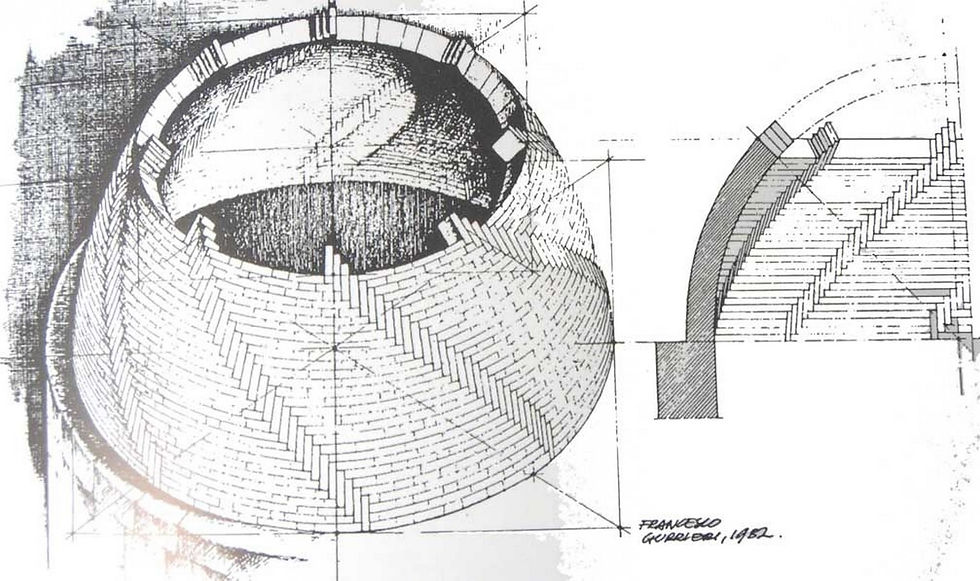The Story of Herringbone
- computers67
- Oct 29
- 4 min read
Herringbone strutting is a traditional form of timber bracing, recognized by its characteristic cross brace arrangement between joists. It was introduced in Britain in the late 19th century to reduce floor movement while allowing services to pass between joists.

It was first employed in Britain in the late 19th century, where space was required between floor joists for services. The practice was introduced into Australian carpentry around the same time, with two RBA projects, the Alfred Stables at Alfred Hospital (1870s) and Dan Murphy’s basement in the Prahran Arcade (1890), being notable Melbourne examples.
However, the herringbone story has its origins in the textile industry and predates the 19th century altogether. The pattern is formed by placing rectilinear shapes in a serrated arrangement where each shape meets the other at a right angle. In addition to providing excellent interlocking strength when applied to textiles, it also creates a sense of movement and direction.
The earliest confirmed evidence of herringbone textiles was from an assemblage of over 160 artefacts uncovered within the Hallstatt salt mines in Austria dating back 2800 years (1). The low temperatures and salt-rich conditions allowed for the unique preservation of organic materials, such as wool, leather, and linen, which would normally decompose (2). Similar discoveries were later made in the Zillertal Alps in northern Italy in 1992, including outer leggings woven in a herringbone pattern (3).

While the herringbone pattern would be continuously used in textiles across Europe, it wasn’t until the turn of the millennium that it would be applied to architecture and construction. The pattern became known as opus spicatum, or spiked work, a term coined by the late 1st century Roman architect Vitruvius. It is commonly believed that the Romans were inspired by the skeleton of the herring fish, but the arrangement of bricks alluded to the ears of wheat, a prominent symbol representing Ceres, the Roman deity of agriculture and fertility (4).

Opus spicatum could be found in the paving of vestibules, porticoes, courtyards, and other public spaces not just for its design but for its mechanical advantages. The interlocking pattern could be laid with smaller stones, and distributed compressive loads effectively, particularly when aligned in the direction of foot traffic (5).
A significant application of opus spicatum can be found in the upper levels of the marketplace in Trajan’s Forum. It was completed 107 - 113 CE under the direction of architect Apollodorus of Damascus in commemoration of Emperor Trajan’s military feats in Dacia. The forum was a direct representation of the Roman Empire at the height of its imperial power (6).

Despite its strength, opus spicatum was rarely used in vertical construction in Rome. But the Santa Pudenziana (140-155 CE) and a tomb at the site of Pećine in Viminacium in modern day Serbia (c. 450 CE) are notable exceptions. Even when the pattern more closely resembled chevron, with stones meeting to form a V shape, it was still referred to as opus spicatum. Beyond its structural use, it served as a decorative feature giving variety to the walls surface and was a practice that persisted well into late antiquity and medieval.


Because many of the construction techniques in classical antiquity faded from use, it is unlikely that future civilizations were aware of the name opus spicatum. It is more likely that the knowledge survived via oral tradition, and that the terms herringbone and opus spicatum are names that we apply retrospectively. The technique would be employed across Norman and Saxon structures across Britain from the 9th century, such as the All Saints Church in Brixworth (c.800), and Tamworth Castle (C.1080).


It wasn’t until the Renaissance that the herringbone pattern reemerged with greater structural and architectural significance (7). It became central to the construction of Filippo Brunelleschi’s dome for Santa Maria Del Fiore in Florence, Italy (completed 1296-1436). The dome was based upon Neri di Fioravanti’s model which had no external buttresses. The rejection of Gothic buttresses, driven by their association with Italy’s enemies to the north, became one of the first defining moments of the Italian Renaissance in 1367 (8).

Inevitably, the dome’s construction proved to be a challenge – it had to be octagonal, self-reinforcing, and resist collapsing outwards. In addition to an outer and inner dome which resisted collapse, Brunelleschi devised a spiraling herringbone arrangement of stretchers interrupted by soldiers, which allowed for the bricks to self-reinforce as they were laid.

Following the dome’s success, Antonio da Sangallo the Younger developed a cross-herringbone technique, creating a double loxodromic curved system that would later influence structures like the geodesic dome. It marked a turning point not just in architecture, but in the understanding of pattern, geometry, and load distribution (9).


For more than 2,800 years, the herringbone pattern has featured prominently in textiles, Roman paving, and architecture, celebrated for its inherent strength and interlocking ability. Though its direct connection to herringbone bracing remains unclear, the same principle of structural rigidity helped shape the evolution of cross bracing which later inspired herringbone bracing in the 19th century.
References:
Ancient textiles — recent knowledge: a multidisciplinary research project on textile fragments from the prehistoric salt mine of Hallstatt, Regina Hofmann-de Keijzer
Hallstatt – an archaeological treasure trove – Natural History Museum Vienna
Iron Age Textiles artefacts from Riesenferner/Vedretta di Ries - Bozen/Bolzano - Italy, Marta Bazzanella
A Guide to Ceramic Building materials, York Archeological Trust, J.M. McComish
Opus Spicatum: A History of Herringbone, Will Belcher
A War Diary Soars Over Rome, National Geographic
Opus Spicatum: A History of Herringbone, Will Belcher
Florence Cathedral, Wikipedia
From the herringbone dome by Sangallo to the Serlio floor of Emy (and beyond)_ Giulio Mirabella Roberti




Comments